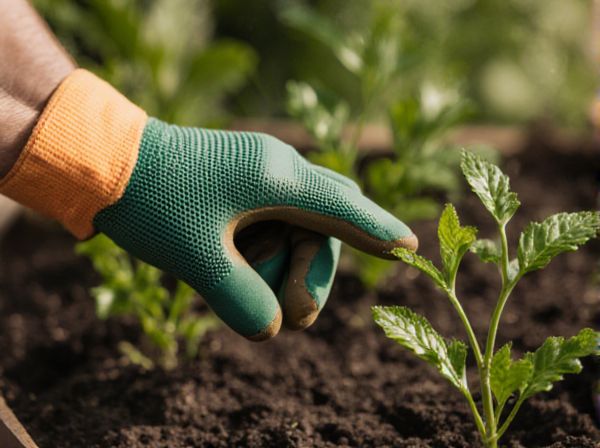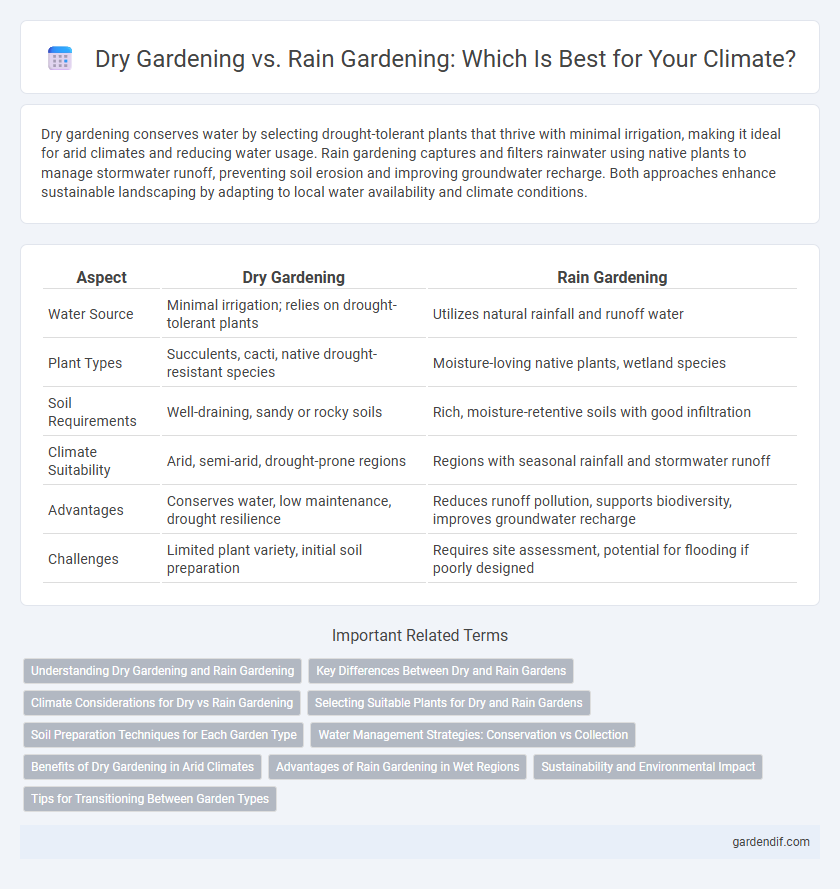
Dry gardening vs Rain gardening Illustration
Dry gardening conserves water by selecting drought-tolerant plants that thrive with minimal irrigation, making it ideal for arid climates and reducing water usage. Rain gardening captures and filters rainwater using native plants to manage stormwater runoff, preventing soil erosion and improving groundwater recharge. Both approaches enhance sustainable landscaping by adapting to local water availability and climate conditions.
Table of Comparison
| Aspect | Dry Gardening | Rain Gardening |
|---|---|---|
| Water Source | Minimal irrigation; relies on drought-tolerant plants | Utilizes natural rainfall and runoff water |
| Plant Types | Succulents, cacti, native drought-resistant species | Moisture-loving native plants, wetland species |
| Soil Requirements | Well-draining, sandy or rocky soils | Rich, moisture-retentive soils with good infiltration |
| Climate Suitability | Arid, semi-arid, drought-prone regions | Regions with seasonal rainfall and stormwater runoff |
| Advantages | Conserves water, low maintenance, drought resilience | Reduces runoff pollution, supports biodiversity, improves groundwater recharge |
| Challenges | Limited plant variety, initial soil preparation | Requires site assessment, potential for flooding if poorly designed |
Understanding Dry Gardening and Rain Gardening
Dry gardening employs drought-tolerant plants to minimize water use, making it ideal for arid climates and regions facing water scarcity. Rain gardening captures and filters stormwater runoff by planting native species in shallow depressions, reducing soil erosion and improving groundwater recharge. Both techniques contribute to sustainable landscaping by conserving water and enhancing ecosystem resilience.
Key Differences Between Dry and Rain Gardens
Dry gardens utilize drought-tolerant plants that thrive with minimal water, relying primarily on soil moisture retention and efficient irrigation methods. Rain gardens are designed to capture and filter stormwater runoff using native, moisture-loving plants that help reduce flooding and improve water quality. Key differences include plant selection based on water needs, garden purpose focusing on water conservation versus stormwater management, and soil design tailored for either water absorption or retention.
Climate Considerations for Dry vs Rain Gardening
Dry gardening prioritizes drought-resistant plants and efficient water use, making it ideal for arid and semi-arid climates with low annual rainfall. Rain gardening leverages natural precipitation and stormwater runoff to support moisture-loving plants, suited for regions with moderate to high rainfall and seasonal flooding patterns. Climate considerations such as rainfall variability, soil type, and temperature extremes are crucial to selecting the appropriate gardening method for sustainable water management and plant health.
Selecting Suitable Plants for Dry and Rain Gardens
Selecting suitable plants for dry gardening involves choosing drought-tolerant species like succulents, lavender, and native grasses that thrive with minimal water. Rain gardening requires plants adapted to wet conditions and fluctuating moisture, such as Joe-Pye weed, cardinal flower, and swamp milkweed, which help manage stormwater runoff. Prioritizing native plants in both garden types enhances sustainability and supports local biodiversity.
Soil Preparation Techniques for Each Garden Type
Dry gardening soil preparation emphasizes enhancing water retention through organic mulch and soil amendments like compost and biochar to improve moisture conservation in arid conditions. Rain gardening requires creating well-drained, porous soil using sandy loam and incorporating native plants to facilitate rainwater infiltration and prevent erosion. Both techniques prioritize soil structure optimization tailored to moisture availability, promoting sustainable plant growth in diverse climates.
Water Management Strategies: Conservation vs Collection
Dry gardening emphasizes water conservation by selecting drought-tolerant plants and minimizing irrigation to reduce water usage, ideal for arid regions with limited rainfall. Rain gardening focuses on water collection by capturing and utilizing stormwater runoff through depressions planted with water-loving vegetation, enhancing groundwater recharge and reducing urban flooding. Both strategies optimize water management by balancing conservation with sustainable collection based on local climate and soil conditions.
Benefits of Dry Gardening in Arid Climates
Dry gardening thrives in arid climates by utilizing drought-resistant plants that require minimal water, significantly reducing irrigation needs and conserving precious water resources. This method enhances soil moisture retention through mulching and soil conditioning, promoting sustainable landscaping in areas prone to water scarcity. Dry gardening also lowers maintenance efforts and costs while supporting biodiversity by encouraging native plant species adapted to dry conditions.
Advantages of Rain Gardening in Wet Regions
Rain gardening maximizes water absorption and reduces stormwater runoff by capturing rainfall in wet regions, promoting groundwater recharge and decreasing erosion. Native plants used in rain gardens thrive in local conditions, enhancing biodiversity and supporting pollinators while requiring minimal irrigation. This eco-friendly practice also filters pollutants from water, improving overall water quality and contributing to healthier aquatic ecosystems.
Sustainability and Environmental Impact
Dry gardening minimizes water consumption by utilizing drought-tolerant plants and efficient soil management, significantly reducing the need for irrigation. Rain gardening enhances stormwater management by capturing runoff and filtering pollutants, improving groundwater recharge and reducing erosion. Both strategies promote sustainability by supporting local ecosystems and conserving natural resources in varying climatic conditions.
Tips for Transitioning Between Garden Types
Transitioning from dry gardening to rain gardening requires assessing soil permeability and selecting native plants that thrive in seasonal moisture variations. Incorporate rainwater harvesting techniques and amend soil with organic matter to improve water retention without compromising drainage. Gradually introduce rain garden zones to existing dry areas to promote biodiversity and manage stormwater effectively.
Dry gardening vs Rain gardening Infographic

 gardendif.com
gardendif.com